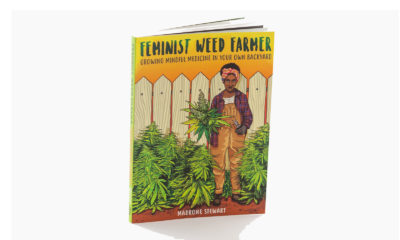Book Review: ‘Cannabis for Seniors’
New work caters the cannabis message to an older population.
Most of us know someone over the age of 65 who could benefit from the effects of cannabis, but who doesn’t because of apprehensions about taking the (perceived) plunge. Maybe they had a bad experience with edibles in their college days, or maybe they were brought up to think that cannabis would turn them into raging lunatics — for whatever reason, they simply don’t trust the herb.
Those people are the target audience of Dr. Beverly “Docpotter” Potter’s new book, “Cannabis for Seniors.” The book is essentially a large-scale (and large-font) list of FAQs; any curious senior citizen (or newbie of any age, for that matter) is likely to have their basic questions answered in the book’s 200 pages. Although at times vague, “Cannabis for Seniors” nevertheless delivers a comprehensive overview of cannabis and its effects, particularly as they pertain to an older audience.
A longstanding life coach, public speaker, writer and psychologist, Potter brings a holistic approach to her writing, mixing in elements of social psychology and dieting to compliment her observations on cannabis. Throughout “Cannabis for Seniors,” she consistently breaks down the different variables of the cannabis equation — ailments, strains of cannabis and the user’s lifestyle — to deliver a message to an audience that may need a little handholding.

For example, before explaining how cannabis could provide relief from a particular ailment or condition, she details the applicable information about the ailment itself — anything from sleep apnea to chemotherapy, anxiety to Alzheimer’s — with statistics, visualizations and graphs. Only then does she begin explaining what exactly it is about cannabis that makes it an applicable treatment.
The approach is a bit repetitive; she reminds her readers throughout the book about the difference between sativa and indica, for instance, or the speed with which different forms of cannabis take effect. But while anyone with experience may find this repetition agonizing, for a newbie, it’s likely pretty helpful.
One of the most compelling chapters of the book focuses on the ongoing opioid epidemic, one of the greatest threats to today’s senior population. Potter points out some alarming statistics: The rate of adults between 45 and 85 being hospitalized for opioid abuse has grown by 500 percent since 1993 and the rate of ER visits for prescription drugs rose by 78 percent between 2006 and 2012 — and half of those patients were over 75.
“It is quite troubling that 40 people die each day as a result of opioid overdoses,” she writes.
Potter’s case for using cannabis as an alternative to prescription opioids is sound, thought-out and well-reasoned. She cites a handful of persuasive studies, including one in which three-quarters of a group of opioid addicts were able to shake their addiction after employing cannabis therapy, and another in which nearly half of participants reduced their opioid intake.
Unfortunately, not all of “Cannabis for Seniors” is so compelling. For seniors on the fence about experimenting with cannabis, or who may associate the plant with brain-dead stoners, Docpotter’s use of cartoonish and awkwardly-placed photographs jeopardizes her ability (and by extension, the cannabis industry’s ability) to be taken seriously by some of the people who stand to benefit the most.
As Docpotter herself points out, the market for senior citizens in cannabis is growing every day. Convincing them will require more than quality information, it will require a sense of legitimacy — something that “Cannabis for Seniors” could use more of. Despite this, the book stands as a good resource for seniors who desire to learn the basics about the plant and its effects.
Originally published in Issue 28 of Cannabis Now. LEARN MORE
TELL US, do you know any seniors who are interested in cannabis education?






















